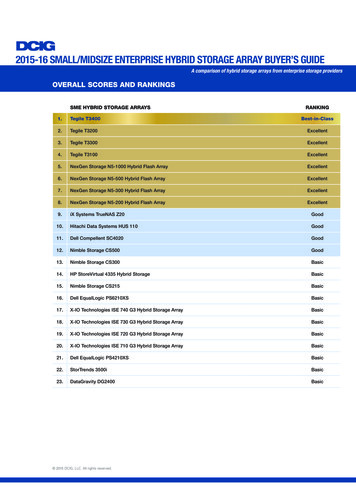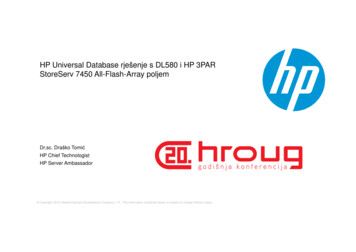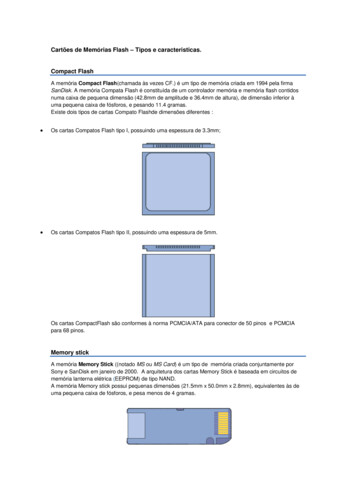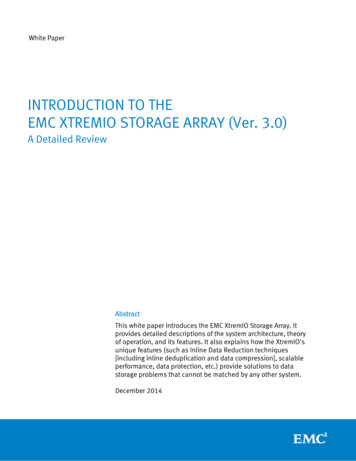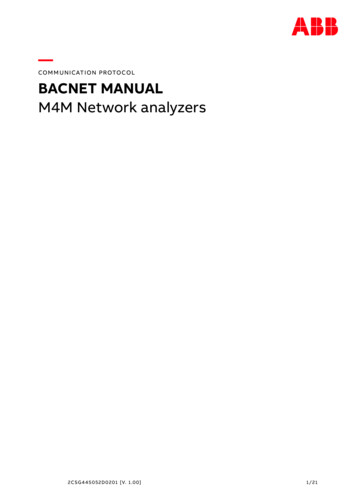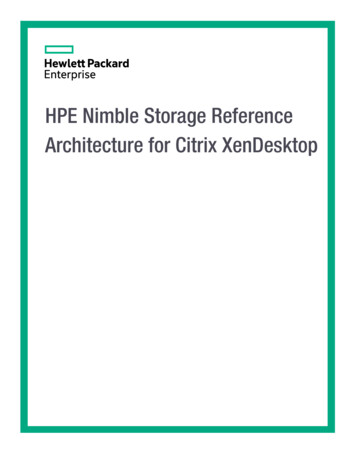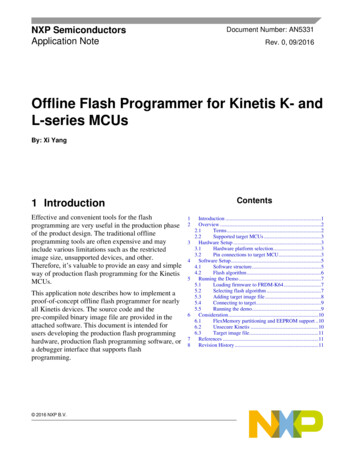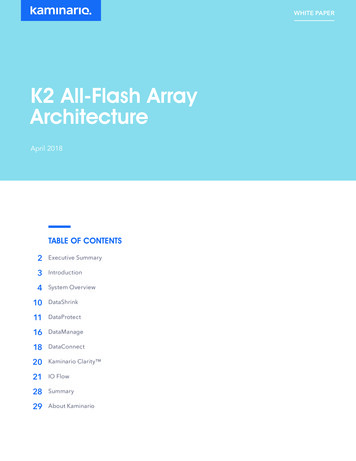
Transcription
WHITE PAPERK2 All-Flash ArrayArchitectureApril 2018TABLE OF CONTENTS2Executive Summary3Introduction4System aConnect20Kaminario Clarity 21IO Flow28Summary29About Kaminario
WHITE PAPERExecutive SummaryFlash and all-flash arrays have become synonymous with performance. However, they have also been regarded asexpensive and lacking the full set of enterprise features, and are better used as a solution for a specific pain point or asingle application.Flash prices have gone down considerably over the last few years and flash as a storage media has gained maturity and sodid the all-flash array market. Customers are looking for all-flash arrays to replace HDD or hybrid-based arrays, howeverthe market is crowded with all-flash products that are based on legacy architectures not fit for flash media, or productsthat are capable of servicing only a single application, not an entire datacenter.In its sixth generation, the Kaminario K2 all-flash array manages to realize Kaminario’s vision of an all-flash datacenter,and make the K2 the right choice for IT departments of the on-demand world, supporting applications such as relationaldatabases, virtual environments, private-cloud implementations, NoSQL databases, containerized applications and more.The K2 all-flash array is an appliance which is a combination of tested and packaged hardware, software and services.K2’s Gen6 hardware platform is based on leading off-the-shelf enterprise components that enable K2’s software-definedarchitecture and software stack. The K2 runs Kaminario VisionOS , the next-generation flash operating system stack,that provides the core software and advanced data services framework.VisionOS enables modular components and services that demonstrate a superior value proposition across a real scaleout storage platform, both in innovation and in ease of use: DataShrink – Data reduction features and capabilities are mandatory for economics of flash storage. Withdifferentiating inline, global, adaptive and selective deduplication, together with inline byte aligned compression,thin provisioning and zero detection, Kaminario is able to establish itself as the cost-efficiency leader of flash storage. DataProtect – Kaminario values its customers’ data more than anything. Native array based snapshots and replicationallow for returning to any point in time in any site. Data-at-rest AES256 encryption makes sure that data is keptprivate and safe at all times. A highly resilient design of no single point of failure, non-disruptive upgrades (NDU) anda robust RAID scheme facilitate 99.999% of data availability. DataManage – The K2 can be managed by various means. Internal management includes an intuitive web-basedGUI, a scriptable CLI and a fully programmable RESTful API platform. DataConnect – K2’s RESTful API allows for external applications of the IT eco-system to easily integrate andseamlessly manage the K2. This eco-system is constantly growing and includes: VMware vSphere, Microsoft VSS,OpenStack, Flocker (containers) and Cisco UCS director.This white paper describes the K2’s architecture and VisionOS, detailing its core features and functionalities and how theycome to play in the Kaminario K2 all-flash array.2
WHITE PAPERIntroductionFlash as a storage media is a game changer. It finally allows storage to match the evolution, progress and performance ofCPU power and networking. However, to use flash in a storage array requires inventing a whole new storage architecture,since the legacy architectures are tightly designed to match the characteristics of spinning disks.VisionOS is designed from the ground up to utilize flash with the insight of preparing for the next generation of flash, CPUand networking. As an example, the K2 uses SSDs in its array, and VisionOS’s metadata design can accommodate anySSD capacity size.Kaminario K2’s scalable architecture and operating system are facilitators for driving flash as general purpose storage tothe next level with the following tangible business benefits: Cost efficiency – Flash storage is considered expensive, but with the right storage efficiency features such as globalinline selective deduplication, inline compression, thin-provisioning and the Kaminario K-RAIDTM, the CAPEX of theK2 all-flash array (AFA) is lower than legacy HDD storage. The K2 AFA is also much more economic on power, coolingand footprint so the OPEX is considerably lower. When comparing the TCO over a period of several years,K2 demonstrates a clear ROI and increased savings over the years. Scalability – The K2 all-flash array’s unique scale-up and scale-out architecture covers both dimensions of scale –capacity and performance. K2 can linearly grow the number of CPU cores by adding K-Blocks and independentlygrow only capacity by adding SSD shelves – thus breaking the limits of rigid architectures that are unable to scaleout or benefit from true shared metadata. K2 Gen6 can scale to multi-petabyte of shared flash storage with dataservices and data reduction that span globally across all the array’s components and management through a singlepane of glass. Performance – The K2 accelerates production with flash performance that serves mixed workloads via a globalvariable block size algorithm. It delivers better user-experience in VDI environments, removes the Input/Output (IO)blender effect from virtual servers and allows the customer to receive real-time reports from analytics environments(OLAP) and faster database queries in OLTP environments, all in a single storage platform.3
WHITE PAPERSystem OverviewGeneralVisionOS is the secret sauce that binds best-of-breed enterprise hardware components to an all-flash array. VisionOS issoftware-defined, meaning it is agnostic to any hardware or technology. VisionOS can easily and economically adapt toany advancements made in CPU power, networking and flash media. Scalability combined with non-disruptive upgradesguarantees continuity and progress of both hardware and software within the array.K-BLOCKThe K-Block is the building block of the K2 all-flash array, and encapsulates the following hardware components: Two K-Nodes, each a 1U storage controller. Each K-Node provides full redundancy for its components:– Four 16Gbps FC ports and two 25GbE iSCSI ports for external host connectivity– Two 40Gbps InfiniBand ports for K-Node backend interconnectivity– Two 12Gbps SAS ports for internal connectivity with the K-Block’s SSD shelves Base SSD shelf, 2U in sizer.– 24 hot-swappable SSDs; datacenter grade SSDs with 3D TLC NAND flash Base SSD shelf, 2U in sizer.– Same as the base SSD shelfFigure 1: Basic K-Block Components4
WHITE PAPERSCALABLE ARCHITECTUREVisionOS is designed to facilitate linear growth in both capacity and performance while maintaining consistent lowlatency, thus implementing a scale-out architecture. In addition, it has the ability to facilitate only growth in capacitywith no impact on performance, thus implementing a scale-up architecture. The combination of both scale-out andscale-up architectures in a single storage array is the key feature for building a storage infrastructure that can scalein the most cost-effective way, ensuring that the exact datacenter requirements for new and existing applications aremet. Any increase in capacity, results in an automated rebalancing of data within the array, with no intervention ofhuman management.The starting point for any K2 all-flash array configuration is a single K-Block, as shown in Figure 2, below:Figure 2: Single K-Block array The K-Nodes are connected redundantly using point-to-point IB connectivity. Each K-Node is connected redundantly to the SSD shelf using SAS connectivity. The K-Nodes have Active/Active connectivity either directly to the host(s) or through a switch, via FC or iSCSI. Volumes and metadata are automatically distributed between all SSDs in the array and can be accessed from everyK-Node in the array.From this basic building block, the customer has the flexibility to scale the K2 all-flash array according to the datacenterneeds, using a scale-up and/or a scale-out approach.5
WHITE PAPERSCALE-UPScaling up means adding more capacity by adding Expansion Shelves without adding K-Blocks.Scaling up a single K-Block with an Expansion Shelf is shown in Figure 3, below:Figure 3: Scaling up a Single K-Block arraywith an Expansion Shelf The expansion increases the capacity density and reduces the cost per GB. The Expansion Shelf is connected redundantly using SAS connectivity. The expansion is done online with no downtime or decrease in performance. The new configuration has the same performance as before. Existing volumes are automatically redistributed between all the SSDs in the array. There is no change required to any of the host connections or definitions. Scale up to a total of four (4) SSD shelves and a total of 96 SSDs in a single K-Block. Mix and match with the most up-to-date and cost-efficient SSD technology and drive size. The expansion process can be seen in the GUI inventory screen, as seen below:Figure 4: Scale-up expansion in-progress6
WHITE PAPERSCALE-OUTScaling out means increasing the number of K-Blocks, thus adding more capacity and compute power.Scaling out from a single K-Block to a dual K-Block array is shown in Figure 5:Figure 5: Scaling Out from a Single K-Block array to a Dual K-Block array The expansion linearly increases the capacity, IOPS and throughput. The latency is kept consistently low and is indifferentto the expansion. Two InfiniBand switches are required to support the interconnect between all the K-Nodes in the array. Scaling beyondtwo K-Blocks will not require any additional networking hardware. The expansion is performed online with no downtime or decrease in performance. Existing volumes are automatically redistributed between all the SSDs in the array and can be accessed from everyK-Node in the array. Metadata is also redistributed between all K-Nodes, thus powering global data services across all K-Blocks and their SSDs. New hosts can be connected to the new K-Block, and the new and existing hosts can access all new and existingvolumes. Scale and mix K-Blocks with the most up-to-date server and SSD technology backed by the Kaminario ForeSight Assured Scale program. The expansion process can be seen in the GUI inventory screen, as seen on the next page.7
WHITE PAPERFigure 6: Scale-out expansion in-progressSCALE-OUT AND SCALE-UPThere is no particular order in which the K2 has to scale. The K2 can first scale up, then scale out and vice versa.This flexibility removes any compromises of using a storage array that is not tailored to the customer’s needs anddatacenter requirements.For example, scaling-up in a dual K-Block array with two Expansion Shelves is shown in Figure 7, below:Figure 7: Scaling Up in a Dual K-Block array8
WHITE PAPERSimilar to the scale-up of a single K-Block, also in this case: The expansion increases the capacity density and reduces the /GB factor. The Expansion Shelves are connected redundantly using SAS connectivity. The expansion is performed online with no downtime or decrease in performance. Existing volumes are automatically redistributed between all the SSDs in the array. There is no change required to any of the host connections or definitions. Scale with the most up-to-date and cost-efficient SSD technology.The system can continue to scale out with K-Blocks and their Expansion Shelves and/or scale up. Continuing the exampleabove, scaling from a dual K-Block array with Expansion Shelves to a quad K-Block array and increasing the number ofSSD shelves to four (4) shelves per K-Block, is shown in Figure 8, below:Figure 8: Scaling from a Dual K-Block array with Expansion Shelves to a Quad K-Block arraySUMMARY TABLEThe ability to accommodate various capacity sizes of SSDs and the flexibility of scalability allows a tailored-fitconfiguration to meet the requirements of the individual customer. The table below captures the most commonconfigurations and capacities.K2 Gen6 All-Flash ArrayScaled Configuration1 K-Block2 K-Blocks3 K-Blocks4 K-BlocksUsable Capacity*70TB-1PB140TB-2PB210TB-3PB280TB-4PBIOPSUp to 370KUp to 740KUp to 1.1MUp to 1.5MThroughputUp to 6.2GB/sUp to 12.4GB/sUp to 18.6GB/sUp to 25GB/sLatency0.35ms*Capacity is subject to drive size and the application data reduction ratio. For some datasets such as VDI the range will be higher9
WHITE PAPERDataShrinkThe ability to build a cost-effective AFA relies almost entirely on the efficiency of the architecture or, in other words, howmuch effective capacity can be generated from raw physical SSD capacity.VisionOS is focused on being highly efficient, but without compromising on other features such as enterprise resiliencyand consistent performance.It is therefore a combination of features that allow the efficient usage of flash media and also complement the attributesof flash. These features play a major role in the IO processing, as described in the IO Flow.DEDUPLICATIONVisionOS’s global inline selective deduplication meets the demanding requirements of eliminating redundant data so thatit is stored on the array only once. The deduplication is performed globally and its processing is distributed across all thearray’s K-Nodes, enabling higher deduplication ratios, high performance and consistent low latency. As the array scalesout, so does the deduplication. VisionOS offers the unique option, amongst AFAs, of selective deduplication. It allowsstoring data without deduplication for applications whose data redundancy is negligible and additional performance ispreferred (such as database applications like Oracle or SQL Server), as well as for security-sensitive applications wherededuplication is prohibited.COMPRESSIONVisionOS uses inline real-time data compression that is optimized for low latency performance. The data reduction isgained regardless of whether the data is dedupable or not, which makes compression the de-facto method of datareduction for non-dedupable data sets that are common in database environments such as Oracle and SQL Server.VisionOS uses software and hardware compression algorithms with the ability to compress data in the granularity of bitswhich achieves greater compression ratios. The compression is performed on 4KB blocks rather than on bigger datasegments, ensuring that small reads do not result in decompression of unnecessary data. The output of a compressed4KB block is rounded to the nearest byte. This byte-aligned compression prevents internal fragmentation and facilitatesbetter compression ratios.10
WHITE PAPERK-RAIDTMKaminario developed the K-RAID - a RAID scheme that is highly efficient with an 87.5% utilization rate. This high rateis gained without compromising on either the protection level, which is an optimized version of RAID6 protection, oron performance. This rate is achieved by deploying efficient erasure coding on each 24 SSD shelf. This erasure codingconsists of two logical RAID groups, each one with a parity (P1 and P2), and an additional parity for the two groups (Q), asshow in Figure 9, below:Figure 9: K-RAID logical layout of two RAID groups and a Q parity for both groupsNote that there are no dedicated parity drives – all data and parity roles rotate between all the drives. The K-RAIDprotection and recovery abilities are detailed in the section.THIN-PROVISIONINGThin-provisioning allows for maximum utilization of the storage array with the ability to plan storage provisioning for thelong term. However, thin-provisioning can be truly utilized only with a scalable architecture that can facilitate capacitygrowth within the array, with no limitations. All the volumes in the K2 are thinly-provisioned, with a fine granular on-demand growth of 4KB. Un-map operations are also supported in the same granularity. VisionOS delivers the requiredmanagement tools that bring the thin-provisioning feature to the next level, where the capacity management of volumeprovisioning is easy and hassle-free.11
WHITE PAPERDataProtectThe Kaminario K2 is architected and built to meet the requirements of the most sensitive enterprise applications.The enterprise resiliency starts by deploying only enterprise grade hardware components and continues with HighAvailability (HA) throughout K2’s design, scalability of fault domains and providing the right features for building anenterprise product. In addition, data is protected from misuse or human error in the application level using nativefeatures such as snapshots and replication.SNAPSHOTSK2’s patented snapshot architecture follows VisionOS’s guidelines of storage efficiency, performance and scalability.Snapshots are created instantly, with no performance impact and they do not take up any capacity. They track only thedeltas from the volume in a 4KB granularity, using a redirect-on-write (RoW) approach. This storage-efficient design alsokeeps the impact on SSD endurance to a minimum. The snapshots can be mounted for read/write purposes, which serveto create additional working environments such as QA, Test&Dev, analytics, backup and more, all at a very low cost ofstorage capacity. Read/write snapshots deliver the same performance of the production volumes, without any impact onthe production volumes.The duration of creating a snapshot has no dependencies on the number or size of the volumes being snapped orhow big the array is. Using the snapshots’ restore functionality for recovery purposes is done without losing any of thesnapshot history and is allowed at any time. The snapshots can be accessed from any of the storage controllers of the K2,without bottlenecks or load balancing of affinity to a specific controller.REPLICATIONReplication provides site resiliency that completes the enterprise datacenter resiliency requirements. K2 leverages itssnapshot architecture to facilitate asynchronous snapshot-based replication between K2 AFAs. Since the replication isbased on the snapshot architecture, there is no impact on the production’s consistent high performance, and deltas of thereplicated copies are captured with no dependencies on the link speed.VisionOS storage efficiency features of deduplication and compression are also used to significantly reduce the amount ofdata sent between arrays.All essential disaster recovery capabilities such as short Recovery Point Objective (RPO) and Recovery Time Objective(RTO) are gained natively without any third-party software components, which are costly and take their toll in the data flow.ENCRPYTIONK2’s 256 bit AES encryption feature ensures that information on the SSDs is not accessible except through the ordinary IOflow of the K2. Any retrieval of data from the drives after their removal from the array will result in encrypted data. Onceencryption is set, all the data in the array is protected. The data that resides on enterprise applications very often hasprivate information or other confidential information that needs protection from unauthorized eyes. Even if the enterprisedestroys failed or replaced drives, they may still want to encrypt their information to cover the case of theft or disasterwhere their drives may be taken out of their control.12
WHITE PAPERK-RAIDTMAside from being highly efficient, the K-RAID is extremely robust. It can sustain two concurrent SSD failures andup to three SSD failures within each separate SSD shelf, without loss of data. As the K2 scales capacity, so does thenumber of system-wide SSD failures that the system can sustain. The K-RAID has a dual parity protection that adaptsaccording to the failure at hand. An SSD failure is quickly recovered thanks to efficient metadata and real-time systemhealth monitoring. It has minimal performance impact during the rebuild and no performance impact on the array’sperformance once the rebuild is completed.K-RAID is built from two logical RAID groups, each one with a parity (P1 and P2), and an additional parity for the twogroups (Q), as show in , below:Figure 10: K-RAID logical layout of two RAID groups and a Q parity for both groupsThe K-RAID layout is pseudo-randomly distributed throughout each SSD shelf, meaning that there is no fixed Parity orData role per SSD and there is no hot spare, meaning that all the SSDs are utilized for protection and performance atall times.The K-RAID is fully automatic and does not require any configuration or human intervention, which means another IT taskis offloaded to the Kaminario K2.K-RAID FLOW1. The flow of how K-RAID works in the scenario of an SSD failure is shown in , below:Figure 11: K-RAID flow during SSD failure The SSD failure is shown in the left RAID group. However, since the K-RAID layout changes within the SSDShelf every 64MB, all the different K-RAID layouts experience a different failure, i.e., D5 is not necessarilyaffected in each layout. To be precise, it will only be D5 in 1/24 of all permutations of the K-RAID layouts.13
WHITE PAPER Due to the different K-RAID layouts, the rebuild process of the failed SSD is performed from all the 23healthy SSDs, which results in considerably faster rebuild times. When reading from a RAID group that lost a Data segment, the XOR calculations are performed only fromthat affected RAID group, which is built roughly from half the SSDs in the SSD shelf, meaning superiorread performance during rebuild. In that RAID group, the Parity segment will take over the role of the lostData segment and the Parity of the unaffected RAID group (P2 in the figure) will become P, a product ofXOR(P1,P2). When reading from a RAID group that lost a Parity segment (P1, P2 or Q), there is no performance hit at all. Once the rebuild is completed, the K-RAID falls back to a RAID6 scheme, meaning it is still capable ofhandling two more concurrent SSD failures without losing data. When the failed SSD is restored, the K-RAID will be restored to its original layout.2. The flow of how K-RAID works in the scenario of a second SSD failure is shown in , below:Figure 12: K-RAID flow during second SSD failure This is a standard RAID6 recovery. When reading from a K-RAID layout that lost a Parity segment (P or Q), there is no performance hit at all. The Parity segment (P) will take over the role of the lost Data segment and the second parity Q will becomethe new (P). Once the rebuild is completed, the K-RAID falls back to a RAID5 scheme, meaning it is still capable ofhandling an SSD failure without losing data. When the failed SSDs are restored, the K-RAID will be restored to its original layout.14
WHITE PAPER3. The Q parity – handling concurrent failures. When two SSDs fail concurrently, the Q parity comes into play for thoseK-RAID layouts that lost two Data segments or a single Data segment and its Parity, as show in , below:Figure 13: Using the Q Parity for two concurrent SSD failures Vision OS uses a set of highly efficient mathematical procedures for rebuilding the data out of the healthyData segments, P and Q. In some of the K-RAID layouts, two concurrent SSD failures will be treated as twosingle, unrelated SSD failures. In other K-RAID layouts, one or two of the lost segments can be P1, P2 or Q.NOSINGLE POINT OF FAILURE (SPOF)NO SINGLE POINT OF FAILURE (SPOF)VisionOS supports a double-everything approach for K2’s hardware components and all data, and metadata at rest isprotected by the dual-parity K-RAID . However, the K2 does not have passive or idle components in the array; all of itsresources are being utilized at all times. There is full redundancy of every component in the system and there is not asingle component that can fail and cause unplanned down time or data loss. Each K-Block is a standalone failure domain,which means that the entire array can sustain more failures as the array scales and the MTBF of the array stays constant.POWER LOSSA storage array with enterprise capabilities must have the ability to sustain a power outage in the datacenter and still keepthe data intact and available for when power returns. Any metadata and/or data that were already acknowledged by thestorage controllers (K-Nodes) before being stored to the K RAID are saved in two distinct K-Nodes for redundancy. EachK-Node in the K2 is equipped with non-volatile memory that will allow the controller to destage any inflight data that has notbeen stored to its K RAID. Data that is already stored to the K-RAID is kept persistent and is sustainable through power cycles.NON-DISRUPTIVE UPGRADES (NDU)The K2 can upgrade any of its hardware and software components with no impact on the availability or performance ofthe array. K2’s architecture is software-defined, so any new feature/enhancement/bug-fix/firmware to VisionOS can bedeployed with no dependencies on maintenance windows or running workloads. In addition, hardware can be replaced/upgraded/added in the same manner. Having NDU combined with a scalable architecture, the K2 provides the best TCOof storage: No fork-lift upgrades, no need to plan down-time, new technologies can be deployed in the existing arrayand growing datacenter needs can be met by adding more capacity and/or performance. All of these operations areperformed non-disruptively and automatically, with no human intervention.15
WHITE PAPERDataManageVisionOS provides a rich set of tools to monitor and manage the K2 all-flash array. These management services do notrequire additional hardware resources, since they are designed to natively use the K2’s K-Nodes and are accessed usingredundant secured 1GbE connections. With DataManage, there is no need to configure RAID groups, tune the array to aspecific application or create affinities between volumes and controllers.GUIThe K2 GUI is slick and highly usable, keeping all the necessary information in a tiled dashboard. Each tile presents theessential details of a K2 management component: Health, Volumes, Replication, Performance, Capacity and Events.Figure 14: K2 GUI Dashboard16
WHITE PAPERClicking a tile will automatically open a more detailed and actionable view of that management component: Createvolumes, snapshots, replication policies, capacity policies, assign hosts, manage FC/iSCSI connections and so on. Thetiles are dynamic and can be rearranged according to personal taste, as can be seen in Figure 15:The GUI is accessible via any web browser and does not require any software installation or separate licensing.Figure 15: K2 GUI Dynamic TilesCLIThe CLI is fully scriptable and allows full control of the features and functionality of the K2. The CLI is accessible via an SSHconnection using a Linux/Unix shell or Putty-like utility.RESTFUL APIThe K2 exposes a full set of RESTful APIs that allows it to be controlled, managed and monitored via automatic third-partysoftware and in-house management platforms. The Kaminario REST API (KREST) is publically available with examples onhow to develop automatic flows.17
WHITE PAPERDataConnectUsing the RESTful API platform, VisionOS allows 3rd party components and independent software vendors (ISV) tomonitor and manage the K2. In addition, other protocols such as SNMP, SMI-S and Syslog are also used with differentplatform. The following details several examples of integrations with leading vendors in the enterprise IT industry.VMWARE INTEGRATIONVisionOS incorporates full support for VMware’s vStorage API for Array Integration (VAAI), allowing offloading hostoperations to the K2 array. This seamless integration is required especially when combined with K2’s global inlinededuplication, which facilitates fast cloning and no extra use of physical capacity.By using the Kaminario Storage Replication Adapter (SRA) in VMware’s Site Recovery Manager (SRM), it is possible tobenefit from K2’s native array-based replication in a VMware environment. Day-to-day K2 administration operationscan be carried out via the K2 vSphere web plug-in delivering the complete user experience of managing the K2 alsofrom VMware’s vCenter environment, and VMware’s LogInsight can be used to aggregate Syslog events for additionalmonitoring capabilities.Figure 16: VMware vSphere Web Client, displaying the Kaminario vCenter Plug-inOPENSTACKOpenStack’s support for agile and scalable deployments of private clouds matches the scalable architecture of the K2.Leveraging K2’s RESTful API, the Kaminario K2 Cinder driver allows OpenStack environments to provision all-flash storagefor private and public clouds.18
WHITE PAPERCISCO UCSThe Cisco UCS director enables the management of the K2 as part of the entire stack of networking and compute, as canbe seen in Figure 17:Figure 17: Kaminario UCS Director Plug-in19
WHITE PAPERKaminario Clarity Kaminario Clarity is a cloud-based analytics platform that extends the capability of the Kaminario K2 all- flash storagearray. Kaminario Clarity includes a comprehensive set of management and monitoring functionalities, including aunique capability to leverage application level intelligence, machine learning and big data analytics – all of whichenable customers to get more productivity out of their storage environment and deliver higher performance forbusiness-critical applications.VisionOS continuously monitors all the array’s components and is able, through a unique decision-making algorithm, todetect in real-time any error that might have a probability of occurring. Any error or change in the system state triggersan automatic real-time event that is sent to Kaminario Support. It is also possible for the storage admin to subscribe to theevents of interest by category such as LUN configuration, FC/iSCSI connectivity, hardware errors and so on.On a periodical basis, the VisionOS collects system-wide information that is sent to Kaminario Clarity, where it is analyzedand processed to recognize issues of performance, configuration, capacity management and mor
seamlessly manage the K2. This eco-system is constantly growing and includes: VMware vSphere, Microsoft VSS, OpenStack, Flocker (containers) and Cisco UCS director. This white paper describes the K2's architecture and VisionOS, detailing its core features and functionalities and how they come to play in the Kaminario K2 all-flash array.

